On 23 November 2022, Wakefield Museums & Castles are celebrating the industrial heritage of Knottingley through a commissioned artwork by David Appleyard.
Knottingley: Fire & Water is an innovative artwork, with illuminations, projections, and local community responses. It will be an evening of wonder, celebration, and community spirit.
Knottingley – Industria Ditat
The coat of
arms of the town of Knottingley has the Latin motto ‘Industria Ditat’, which means
‘Progress through Industry’. It was an appropriate motto for a town so strongly
defined and shaped by industry. This industry was made possible by the town’s
position on the River Aire and the Aire & Calder Navigation.
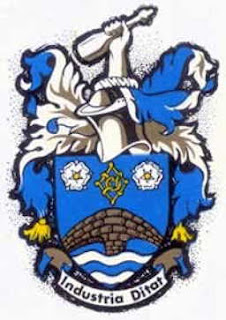 |
Knottingley's coat of arms, also used by the town's Rugby Union club, cricket club and Silver Band. Image from Heraldry Wiki.com. |
Shipbuilding,
glassmaking and coal mining became the dominant industries. The town’s shipyards
built and maintained both inland and seagoing vessels. The glass factories –
the most notable being Bagley and Co – were at the forefront of glass
production and the development of new machinery. Kellingley Colliery, just two
miles away from Knottingley, employed over 2000 miners in its heyday. Ships,
goods, and coal were transported along Knottingley’s waterways, out to the
Humber and beyond, and the town thrived.
Wakefield
Museums & Castles wanted to celebrate this strong industrial heritage by
commissioning an artist to develop a digital artwork, inspired by the town’s
heritage, the museum’s collections, and the stories of former employees. After
a competitive process, they appointed Yorkshire-based artist David Appleyard, well-known for his community-based approach and his focus
on industrial heritage.
For more about David's appointment, click here
‘My home, my life, my community’
As with many
northern industrial towns, Knottingley is navigating a transition and finding a
new identity. Although it has retained its glassmaking industry, with Stoelzle
Flaconnage and Allied Glass remaining large employers in the town, the closure
of Kellingley Colliery and reduction in community facilities have left some in the
town feeling “forgotten” and left behind.
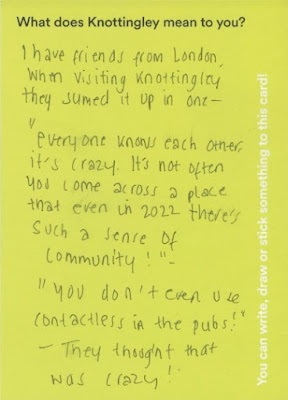 |
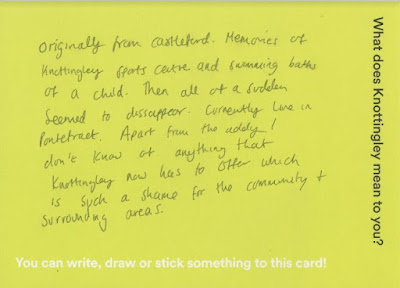 |
| Two of the postcards filled out by members of the community as part of the project (full transcription in alt text) |
Over the
past seven months, David Appleyard has immersed himself in the community,
working closely with local people to reflect on the Knottingley of the present,
as well as the Knottingley of the past. Local people have responded to the
question ‘What does Knottingley mean to you?’ on postcards and beermats, and
local schoolchildren have redesigned the Knottingley coat-of-arms. A mixture of
positive, negative, and indifferent responses has been received. More than 200 people have taken part.
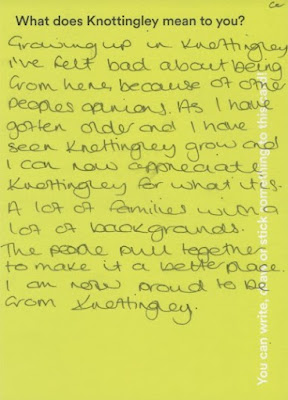 |
| Another postcard from David's community project (full transcription in alt text) |
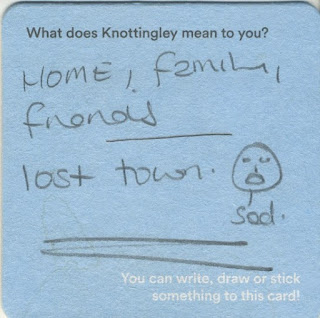 |
A beermat with a response to the question 'What does Knottingley mean to you?' |
Light Up
The
culmination of David’s work exploring Knottingley, both past and present, is
the Knottingley: Fire & Water event on Wednesday 23 November, 5pm - 8pm.
The event
will see some of Knottingley’s iconic industrial buildings illuminated with
light, colour, and historic photographic images. Community responses to
Knottingley today, on postcards and beermats, will be on display in the Town
Hall. There will be free refreshments, entertainment, and performances from
Knottingley Silver Band.
The event is
designed to bring the people together in an evening of celebration, reflection,
and community spirit.
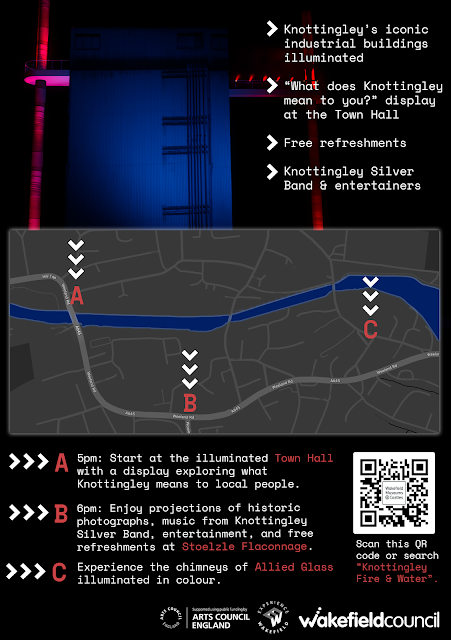 |
| Map of the Event |
So come
along for:
- Illuminated
buildings
- Projections
of historic photographs showing Knottingley’s industrial past
- Knottingley
Silver Band
- Glow
entertainers
- Free refreshments
















%20Former%20women's%20Rugby%20League%20international%20coach,%20Jackie%20Sheldon,%20at%20the%20'Life%20with%20the%20Lionesses'%20exhibition%20in%20Parliament%20-%20photo%20by%20Simon%20Wilkinson.jpg)
